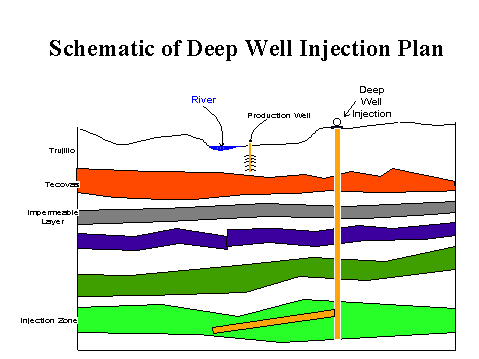
About CRMWA
LAKE MEREDITH SALINITY CONTROL PROJECT
The salinity control project is designed to improve the quality of water in Lake Meredith by intercepting brine water that is leaking into the Canadian River near Logan, New Mexico.

The Problem
Since beginning deliveries of water to member cities of the Authority in 1968, there has been concern about the quality of water available from Lake Meredith. While it was realized that the lake water would be somewhat mineralized, the change in water supply from groundwater was extremely objectionable to some citizens.
A generally increasing trend of chloride content (salt) has occurred, with drought cycles producing chloride contents up to 1500 mg/L in Lake Meredith. Federal Drinking Water Standards recommend maximum chloride contents in drinking water of 250 mg/L and State standards are 300 mg/L. Problems with corrosiveness and mineral deposition accompany the salty taste.
The Cause
Beginning in 1969, the Authority and other agencies have sought to identify the source of the salt water and to determine whether or not water quality in Lake Meredith could be improved. An area in New Mexico just downstream from Ute Dam near Logan was early identified as being a major contributor of saline water to the Canadian River System. Studies by the Bureau of Reclamation and consultants indicate that about 70 percent of the chlorides reaching Lake Meredith originate in this localized area, filtering into the river channel from a shallow brine aquifer which is under artesian pressure. Water in the brine aquifer is roughly as salty as seawater.

The Cure
Extraction Well in Canadian River
Obviously, Lake Meredith water quality should ultimately be improved if the contribution of saline water coming from the brine aquifer were stopped. Because salt is “stored” in the river channel sand between Lake Meredith and Logan, the extent of benefit and the time required to see improvement will depend upon climatic conditions and stream flow, even if all of the salt water inflow were stopped.
Studies indicate strongly that the salt-water flow could be controlled by drilling wells into the shallow brine artesian aquifer, and pumping from those wells to reduce the artesian pressure.
Disposing of the salt water thus produced presents the major problem and expense. Most economical would be a deep disposal or injection well similar to those used by the petroleum or other industries for salt water injection. The right kind of geological strata exists in the area at a depth of 3,000 feet. Suitability of the strata has been determined by drilling and testing. Other disposal methods appear much more expensive than injection wells at the current time.
Below is a sketch roughly showing how we plan on disposing of the brine collected from the production wells.

The Cost
The Salinity Control Project had a total price tag of $11.7 million. It consists of one deep injection well completed both vertically and horizontally. There are currently 7 shallow extraction wells. The total construction cost was $6.5 million. These numbers do not account for annual operating expenses which are around $600,000.
Who Pays?
The State of Texas funded $3 million. The Federal government funded the project investigation, design, and construction management costs through the Bureau of Reclamation, which were about $3.7million. This leaves the balance to be paid by the Canadian River Municipal Water Authority member cities. They have committed to pay up to $5 million for this project.
Now What?
The Lake Meredith Salinity Control Project was placed in operation in September of 2001, producing water from 7 shallow extraction wells and injecting at a rate of 125 gpm.
Reports and Studies
1979 Lake Meredith Salinity Study Appraisal Level Investigation Canadian River.pdf
1984 Lake Meredith Salinity Control Project Hydrology.Hydrogeology.pdf
1984 Preliminary Findings Report - Salinity Control Project.pdf
1985 Analysis of Geophysical Data to Examine the Feasibility of Deep-Well Injection of Brine.pdf
1985 Technical Report on the Lake Meredith Salinity Control Project.pdf
1992 Immediate Phase 2 Studies Salinity Control Project.pdf
1992 Groundwater Data Lake Meredith Salinity Control Project.pdf
1992 Surface Water Data Lake Meredith Salinity Control Project.pdf
1994 Data and Analyses of TW 3 and TW 2 Aquifer Pumping Tests and Water Quality.pdf
1994 Geologic Report from the BUREAU.pdf
1995 Data and Analysis of TW 4 Aquifer Pumping Test and Water Quality Sampling.pdf
1995 Environmental Assessment Salinity Control Project.pdf
1995 Supplement No. 1 to the Geologic Report on the Logan New Mexico Area.pdf
1998 Lake Meredith Salinity Control Project-Bid Drawings.pdf
2000 Technical Report on Construction on Salinity Control Project.pdf
2000 Specifications and Contract Documents for Construction of Salinity Control Facilities.pdf
Project Data
All River Survery Data 1992 - 2009.xls.xlsx
Production Wells, Injection Wells and Observation Wells Data.xlsx
